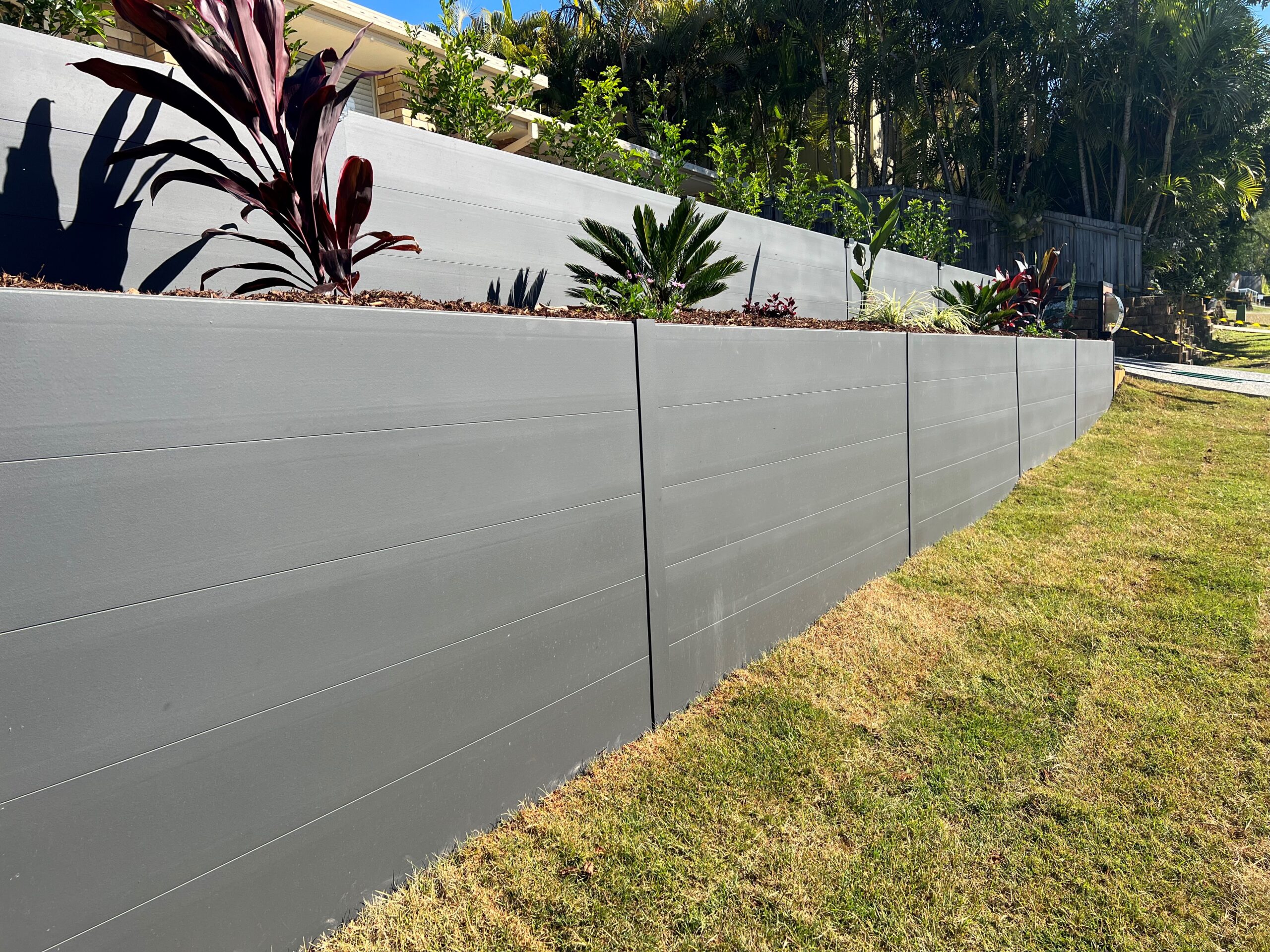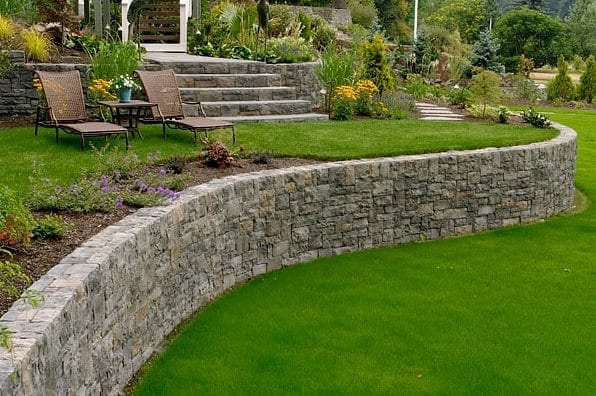The Ultimate Guide to Keeping Retaining Walls Sunshine Coast
The Ultimate Guide to Keeping Retaining Walls Sunshine Coast
Blog Article
Making Sure Structural Stability: The Value of Properly Built Keeping Walls in Protecting Against Slope Failing
In the realm of civil engineering and building, the significance of appropriately created retaining wall surfaces in averting slope failing can not be underrated. By exploring the elaborate interaction between these components, a deeper understanding of the crucial duty that preserving walls play in maintaining structural stability and avoiding incline failing arises.
Duty of Retaining Walls in Security
The necessity of maintaining walls in ensuring slope security is critical in civil engineering techniques. Retaining walls serve a critical role in preventing soil disintegration, taking care of water overflow, and preserving the structural integrity of slopes. By supporting upright or near-vertical grade changes, keeping wall surfaces assist to rearrange side stress exerted by the dirt, thus lowering the threat of slope failing.
One trick feature of retaining wall surfaces is to counteract the pressure of gravity acting upon the dirt mass behind them. This is attained via appropriate layout and construction, which thinks about aspects such as dirt kind, wall surface elevation, drainage arrangements, and potential additional charge loads. By effectively retaining soil within specified limits, these frameworks aid to stabilize slopes and avoid landslides.
Moreover, retaining walls contribute to the aesthetic appeals of landscapes while providing practical benefits. They can develop terraced degrees for landscape design, assistance roadways or frameworks on hillsides, and improve the overall functionality of sloped surface. Basically, preserving wall surfaces play an essential function in preserving slope security and ensuring the safety and security and longevity of civil design tasks.
Factors Influencing Wall Effectiveness
Factors that affect the performance of preserving walls include dirt residential properties, wall surface layout, and outside lots. Dirt properties play an essential role in determining the security and performance of a retaining wall surface. Elements such as dirt type, cohesion, inner rubbing angle, and groundwater conditions can impact how well a wall surface keeps the dirt behind it. The style of the keeping wall is an additional essential element that affects its efficiency. Correct wall style considers factors like wall height, wall surface kind (e.g., gravity wall surfaces, cantilever wall surfaces), support products, water drainage systems, and construction techniques to guarantee the wall can withstand the side pressure put in by the retained dirt. Furthermore, outside lots, such as additional charge tons from adjacent frameworks or website traffic, seismic forces, and water stress, should be meticulously reviewed throughout the layout and building and construction stages to make certain the wall surface can sufficiently resist these outside pressures. By considering these elements adequately, designers can construct preserving wall surfaces that properly avoid incline failing and make certain lasting architectural honesty.
Style Factors To Consider for Preserving Wall Surfaces
Integrating the critical elements of soil homes and outside loads into the architectural design process is crucial for establishing efficient keeping walls that make sure incline stability. When making maintaining walls, engineers should very carefully review the qualities of the bordering soil, including its compaction, water drainage, and type buildings. Understanding these soil residential or commercial properties is essential for figuring out the suitable wall surface density, support, and elevation required to endure the lateral pressure put in by the dirt mass.
Furthermore, outside loads such as additional charge lots from neighboring frameworks or web traffic, as well as seismic pressures, should be taken right into account throughout the design stage. These lots can considerably impact the stability and performance of a maintaining wall, demanding the use of appropriate design strategies and materials to reduce prospective failure risks.
In addition, the selection of suitable products, such as concrete, rock, or lumber, should align with the site-specific problems and aesthetic demands. Aspect of safety considerations, water drainage stipulations, and building and construction methods are likewise important elements that influence the total style and capability of keeping discover this info here wall surfaces in stopping slope failing. By meticulously taking into consideration these layout considerations, engineers can guarantee the architectural honesty and long-term security of retaining walls.

Construction Best Practices for Durability
When constructing retaining walls for ideal resilience and long life, adherence to industry-standard strategies and precise focus to information are critical. To ensure the longevity of a retaining wall, appropriate website prep work is essential.
Incorporating reinforcement strategies, such as geogrids or steel bars, can enhance the structural honesty of the keeping wall and protect against prospective failures. By following these building and construction best methods, retaining walls can endure the test of time and efficiently avoid slope failure.
Relevance of Correct Upkeep
Routine upkeep is important for maintaining the architectural honesty and functionality of retaining walls over time. To make sure that preserving wall surfaces find this continue to perform their designated feature properly, regular assessments need to be performed to recognize any type of indicators of wear and tear.

Verdict
Finally, preserving wall surfaces play a crucial function in making certain structural stability and protecting against slope failing. By taking into consideration factors affecting wall efficiency, sticking to create considerations, adhering to building ideal practices, and applying appropriate maintenance, the sturdiness of maintaining walls can be maximized. Retaining Walls Sunshine Coast. It is important to identify the relevance of correctly created keeping walls in preserving security and avoiding prospective hazards linked with slope failing
Factors that affect the performance of keeping walls include dirt residential properties, wall design, and exterior tons. resource Proper wall design takes into consideration factors like wall surface height, wall surface type (e.g., gravity wall surfaces, cantilever walls), support products, drainage systems, and construction methods to ensure the wall surface can endure the lateral stress applied by the retained dirt. By considering these factors adequately, designers can construct retaining walls that properly avoid incline failing and make certain lasting structural honesty.
Maintenance tasks may consist of getting rid of drain systems to avoid water build-up behind the wall surface, fixing any kind of visible splits or damages, and making certain that the wall is free from plant life that might exert pressure on the framework. By taking into consideration variables affecting wall efficiency, sticking to develop considerations, complying with building and construction finest practices, and implementing proper upkeep, the resilience of preserving wall surfaces can be maximized.
Report this page